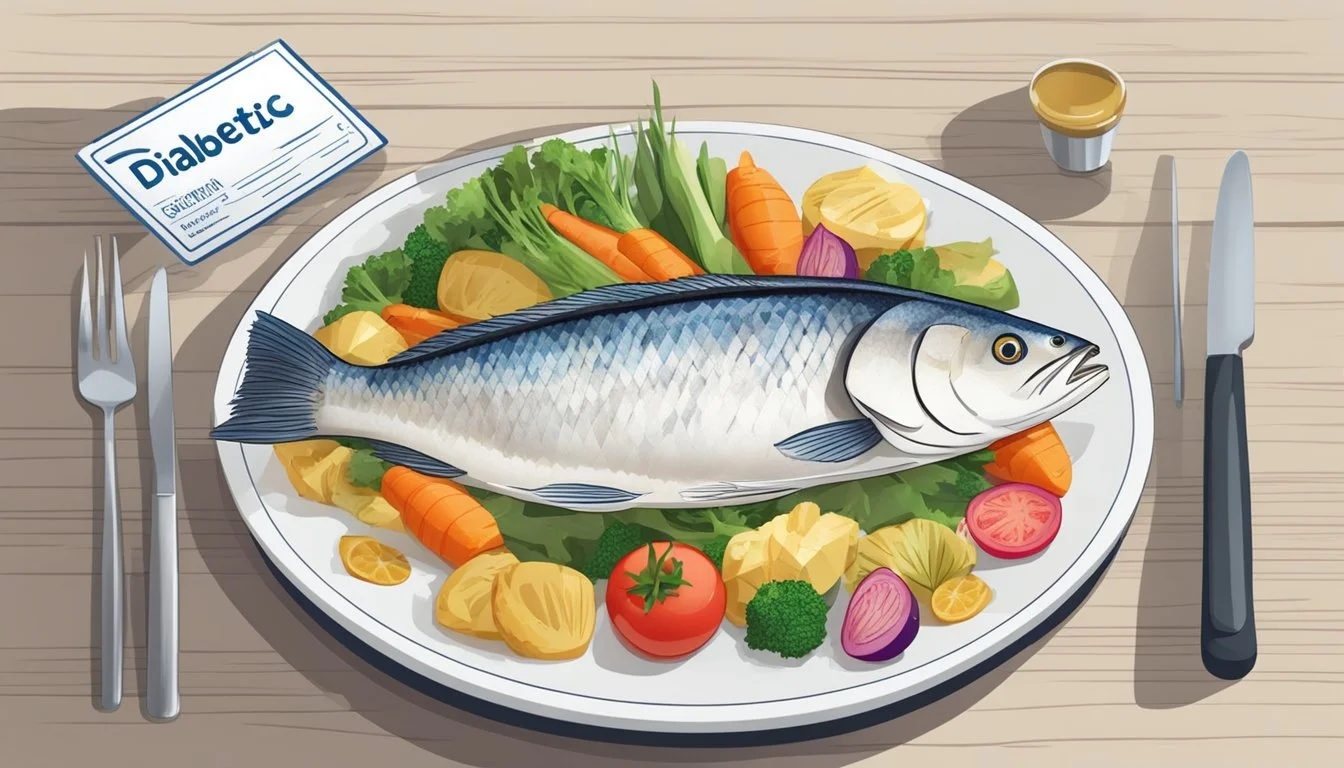Can Diabetics Eat Butterfish?
Health Considerations and Benefits
Butterfish, a delightful seafood option known for its rich flavor and tender texture, often raises questions about its suitability for diabetics. Diabetics can indeed eat Butterfish; it is a healthy choice due to its high protein content and beneficial omega-3 fatty acids. These nutrients are essential for maintaining heart health and managing blood sugar levels.
Additionally, Butterfish is low in carbohydrates, making it a suitable option for those managing diabetes. Its nutritional profile supports overall well-being without causing significant fluctuations in blood sugar. Including Butterfish in a balanced diet can contribute to variety and satisfaction while adhering to dietary guidelines for diabetes management.
With its palatable taste and nutritional benefits, Butterfish can be an enjoyable and diabetes-friendly addition to the meal plan. Exploring recipes and preparation methods can ensure a delicious and health-conscious dining experience.
Understanding Diabetes and Diet
Diet plays a fundamental role in managing diabetes effectively. It's essential to focus on balancing macronutrients to maintain stable blood sugar levels and achieve optimal glycemic control.
The Role of Diet in Managing Diabetes
For individuals with diabetes, monitoring food intake is crucial. Certain foods can spike blood sugar levels, while others help maintain balance.
Carbohydrates have a significant impact on blood sugar levels. Foods high in refined carbs and sugar can cause rapid spikes in blood sugar. These should be limited to maintain control.
Insulin is needed to help glucose enter cells for energy. People with diabetes may not produce enough insulin or can't use it effectively. This makes managing carbohydrate intake especially important.
Choosing complex carbohydrates like whole grains, vegetables, and legumes is beneficial. These cause slower increases in blood sugar. Additionally, foods rich in fiber help in regulating blood glucose levels.
Macronutrient Balance and Blood Sugar Control
Balancing macronutrients—carbohydrates, proteins, and fats—is key for those with diabetes.
Carbohydrates: Consuming complex carbs and monitoring portion sizes can prevent blood sugar spikes. Foods with a low glycemic index are preferred as they raise blood sugar levels more gradually.
Proteins: Protein sources like lean meat, fish, eggs, and legumes can help in maintaining steady blood sugar levels. They also promote satiety, preventing overeating and spikes.
Fats: Healthy fats, such as those from avocados, nuts, seeds, and olive oil, should be included. Saturated fats should be limited to reduce the risk of heart disease, common in those with diabetes.
Monitoring and adjusting food intake based on blood sugar readings can help manage diabetes more effectively. Keeping a balanced diet supports overall health and helps in maintaining stable HbA1c levels.
Nutritional Profile of Butterfish
Butterfish is a nutrient-dense option that provides notable amounts of protein, fats, and essential vitamins and minerals. It can be a valuable addition to the diet of someone managing diabetes, provided that it is consumed in moderation and as part of a balanced meal plan.
Macronutrient Breakdown
Butterfish is rich in protein and low in carbohydrates. Each 100 grams of butterfish contains approximately 22.15 grams of protein, which is essential for maintaining muscle mass and supporting metabolic functions. The fish is also relatively low in calories, providing about 187 calories per 100 grams.
Fat content in butterfish is notable, with 8.02 grams of fat per 100 grams. This includes both saturated and unsaturated fats. Notably, butterfish contains omega-3 fatty acids, which are beneficial for heart health. However, its cholesterol content is 65 milligrams per 100 grams, which should be considered by those monitoring their cholesterol levels.
Vitamins and Minerals in Butterfish
Butterfish offers a variety of essential vitamins and minerals. For instance, it provides 0.61 micrograms of Vitamin B-12 per 32 grams, which supports nerve function and the production of red blood cells. It also contains 11.7 micrograms of Selenium, an important antioxidant.
Additional nutrients include 77 milligrams of Phosphorus, crucial for bone health, and 481 milligrams of Potassium, which helps maintain healthy blood pressure levels. The fish is a source of other B vitamins like Vitamin B3 (1.44 milligrams) and Vitamin B6 (0.096 milligrams), both of which play roles in energy metabolism.
The Benefits of Seafood in a Diabetes Diet
Incorporating seafood into the diet of someone with diabetes offers several advantages. Key benefits include the rich presence of omega-3 fatty acids, which support heart health, and the availability of lean protein, both contributing to better management of type 2 diabetes.
Omega-3 Fatty Acids and Heart Health
Seafood, notably fish such as mackerel and sardines, is abundant in omega-3 fatty acids. These healthy fats play a vital role in reducing inflammation and lowering the risk of heart disease, a common complication for individuals with type 2 diabetes. Omega-3s also improve blood vessel function, which contributes to better heart health.
Lean protein in seafood supports muscle maintenance without adding unhealthy fats. Furthermore, seafood often contains vitamin D, essential for bone health and immune function. Including foods rich in omega-3s helps manage blood sugar levels and supports overall cardiovascular health, making it a beneficial component in a diabetes-friendly diet.
Assessing Fats and Oils for Diabetes
When managing diabetes, understanding the types of fats and oils to include in your diet is crucial. Various fats have different impacts on blood glucose levels and heart health.
Unsaturated vs. Saturated Fats
Unsaturated fats, found in foods like olive oil, avocados, nuts, and seeds, are generally more beneficial. They can help improve blood cholesterol levels, reduce inflammation, and stabilize heart rhythms.
Saturated fats, on the other hand, are typically present in butter, lard, and certain tropical oils like coconut oil. Consuming too many saturated fats can raise LDL cholesterol levels and increase the risk of heart disease. For diabetics, this is particularly important as they face a heightened risk of cardiovascular complications.
Healthy Alternatives to High-Fat Foods
Choosing healthier fat sources can significantly benefit those managing diabetes. Olive oil is an excellent alternative, rich in monounsaturated fats that support heart health. Additionally, incorporating avocados into meals provides both creaminess and healthy fats.
Nuts and seeds also make for nutritious snacks or meal additions. They are rich in unsaturated fats and offer various essential nutrients. For cooking, oils like canola oil or walnut oil offer better fat profiles compared to traditional high-saturated fat sources. Emphasizing these healthier options can help manage diabetes more effectively.
Incorporating Butterfish into a Diabetic Diet
Butterfish can be included in a diabetic diet with careful planning to ensure balanced nutrition, appropriate portion sizes, and controlled frequency. It's essential to manage calorie intake and consult with a dietitian for personalized advice.
Meal Planning and Butterfish
When planning meals that include butterfish, it's crucial to consider the overall balance of nutrients. Butterfish is a good source of lean protein, which aids in blood sugar control and maintaining a healthy weight. Ensure to pair it with non-starchy vegetables and whole grains to create a balanced meal.
Including healthy fats like avocado or nuts can help manage blood pressure levels. Avoid sauces high in sugar or unhealthy fats, which could disrupt blood sugar levels. Consulting with a dietitian can help tailor meal plans to individual dietary needs and preferences.
Recommended Serving Sizes and Frequency
Moderation is key when incorporating butterfish into a diabetic diet. A typical serving size of butterfish is around 3 to 4 ounces, which provides adequate protein without excessive calories. Limiting butterfish to two or three times a week ensures variety in the diet and prevents overconsumption.
Adhering to recommended serving sizes helps keep calorie and fat intake in check, benefiting weight management and blood sugar levels. Regular monitoring and adjustments with the help of a dietitian can enhance the benefits of including butterfish in a diabetic diet. Ensuring proper portion control aids in maintaining a balanced and health-conscious approach to managing diabetes.
Comparative Analysis of Fish Varieties
Different fish provide distinct benefits, especially for diabetics. Butterfish is often compared to other popular fish in terms of nutritional value and diabetes management potential.
Butterfish vs. Other Popular Fish
Butterfish is known for its mild flavor and soft texture. It contains moderate levels of omega-3 fatty acids.
Salmon, rich in omega-3s, offers anti-inflammatory benefits, which can help manage blood sugar levels. Mackerel and sardines are also high in these fatty acids and essential nutrients like vitamin D and selenium.
Tuna provides lean protein, but it’s higher in mercury, so it should be consumed in moderation. Trout and cod are low-calorie options with high protein, beneficial for maintaining a healthy weight, which is crucial for diabetes management.
Shrimp, crab, and lobster are lower in fat but rich in protein, making them good choices if watching fat intake. However, they are higher in cholesterol.
Choosing Fish for Optimal Diabetes Management
When selecting fish for a diabetes-friendly diet, consider omega-3 content, mercury levels, and overall nutritional profile.
Fatty fish like salmon and mackerel offer high omega-3 levels, aiding in reducing inflammation and improving insulin sensitivity.
Lean fish such as cod and trout are excellent for those aiming for low-calorie, high-protein diets. They help maintain a healthy weight which is key for diabetes control.
Shellfish options like shrimp, crab, and lobster provide variety and are lower in fat. They are particularly beneficial for managing cholesterol levels.
By comparing these factors, diabetics can make informed choices to enhance their diet and manage their condition effectively.
Potential Risks and Considerations
When considering the consumption of Butterfish for diabetics, it is crucial to pay attention to mercury levels and potential allergic reactions.
Mercury Content and Seafood Safety
Butterfish, like many seafood options, can contain mercury—a heavy metal that poses health risks. For individuals with diabetes, mercury can potentially affect their overall health, including cardiovascular functions. The American Diabetes Association advises monitoring mercury intake to avoid exacerbating health issues.
Despite Butterfish's nutritional benefits, consuming it in moderation is wise. A weekly serving should be limited to reduce mercury exposure. People also need to consider sodium content, which can influence blood pressure, especially in those with diabetes.
Allergy and Food Sensitivity Awareness
Seafood allergies are fairly common, and Butterfish can trigger allergic reactions in some people. Symptoms may include itching, swelling, and gastrointestinal distress. It's essential for diabetics to identify any potential sensitivities to prevent adverse reactions.
Moreover, high cholesterol levels linked with certain seafood can impact weight management and obesity, which are common concerns for diabetics. Consulting healthcare professionals before adding Butterfish to the diet can help mitigate these risks and ensure safe dietary practices.
In summary, being mindful of mercury content and possible allergies is vital when incorporating Butterfish into a diabetic diet. Consulting a healthcare provider ensures these risks are managed effectively.
Additional Dietary Considerations for Diabetics
Diabetics must be mindful of their dietary choices to manage blood sugar levels effectively. This involves focusing on whole foods and managing carbohydrate intake carefully.
Importance of Whole Foods
Whole foods, such as vegetables, whole grains, and fruits, are crucial for diabetics. These foods help maintain stable blood sugar levels due to their high fiber content. Fiber slows down glucose absorption, reducing spikes in blood sugar levels. Non-starchy vegetables like broccoli, spinach, and bell peppers are particularly beneficial due to their low glycemic index.
Incorporating legumes such as beans and lentils adds protein and fiber to the diet. Whole grains, including brown rice, quinoa, and oats, are preferable to refined grains. They provide sustained energy and essential nutrients. Fruits like berries and apples offer vitamins and antioxidants, but portion control is essential to manage sugar intake.
Managing Carbohydrates and Starchy Foods
Carbohydrates play a significant role in blood sugar management. Diabetics should prioritize non-starchy vegetables and limit starchy vegetables like potatoes and corn. Monitoring carbohydrate intake by counting grams or using the plate method helps maintain proper glucose levels.
Including high-fiber carbohydrates, such as grains and legumes, offers slow-digesting options that stabilize blood sugar. For proteins, options like lean meats, fish, and plant-based sources are ideal. Quality carbohydrates should be spread throughout the day to avoid overwhelming the body's insulin response.
Using beans and whole grains in meals helps manage satiety and glucose levels effectively. Avoiding high glycemic index foods can prevent rapid increases in blood sugar, making diet management more manageable for diabetics.
Foods to Limit or Avoid in a Diabetes Diet
For those managing diabetes, being mindful of certain foods is crucial for maintaining stable blood sugar levels and overall health. Key foods to limit include those high in sugar, processed items, and unhealthy fats.
High-Sugar and Processed Foods
Sugar-sweetened beverages, such as soda and sports drinks, can cause rapid spikes in blood glucose levels. It's best to avoid these drinks and opt for water or unsweetened beverages instead.
Packaged pastries and baked goods are typically high in refined sugars and can also lead to blood sugar spikes.
Refined grain products, like white bread and white rice, are less beneficial as they lack fiber. Choosing whole grain alternatives can be more supportive of balanced blood glucose levels.
Sweetened fruits, including canned or dried fruits with added sugars, should be limited. Unsweetened versions are a better choice.
Processed foods often contain added sugars and unhealthy fats, making them less suitable for a diabetes-friendly diet.
Fatty Meats and Unhealthy Fats
Processed meats like hot dogs, sausages, and bacon are high in saturated and trans fats. These fats can negatively impact insulin sensitivity and heart health.
Red meat should also be consumed in moderation. Lean protein options, such as poultry and fish, are preferable.
Fried fish and other fried foods tend to be high in trans fats, which can contribute to insulin resistance and inflammation.
Unhealthy fats include saturated fats found in butter and fatty cuts of meat. Consumption of these should be limited and replaced with healthier fats like those from nuts, seeds, and avocados.
By focusing on these dietary changes, individuals with diabetes can better manage their condition and reduce the risk of complications.










